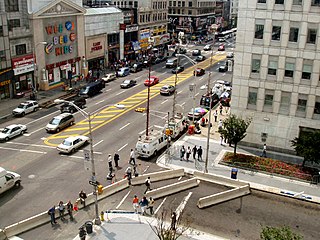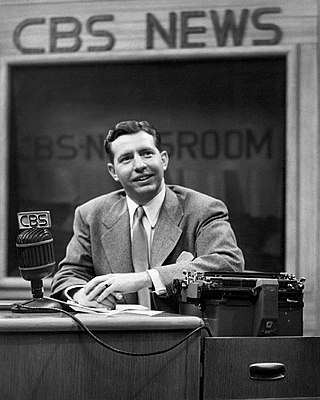The CBS Evening News is the flagship evening television news program of CBS News, the news division of the CBS television network in the United States. The CBS Evening News is a daily evening broadcast featuring news reports, feature stories and interviews by CBS News correspondents and reporters covering events around the world. The program has been broadcast since July 1, 1941, under the original title CBS Television News, eventually adopting its current title in 1963.

The news media or news industry are forms of mass media that focus on delivering news to the general public. These include news agencies, newspapers, news magazines, news channels etc.

Television news in the United States has evolved over many years. It has gone from a simple 10- to 15-minute format in the evenings, to a variety of programs and channels. Today, viewers can watch local, regional and national news programming, in many different ways, any time of the day.
The National is a Canadian national television news program which serves as the flagship broadcast for the English-language news division of CBC News by the Canadian Broadcasting Corporation. It reports on major Canadian and international news stories, airing on CBC Television stations nationwide Sunday to Friday at 10:00 p.m. local time.
WGME-TV is a television station in Portland, Maine, United States, affiliated with CBS. It is owned by Sinclair Broadcast Group, which provides certain services to Waterville-licensed Fox affiliate WPFO under a local marketing agreement (LMA) with Cunningham Broadcasting. However, Sinclair effectively owns WPFO as the majority of Cunningham's stock is owned by the family of deceased group founder Julian Smith. Both stations share studios on Northport Drive in the North Deering section of Portland, while WGME-TV's transmitter is located on Brown Hill west of Raymond. The station also maintains regional studios in the Lewiston/Auburn area, and the state capital in Augusta.
KIRO-TV is a television station in Seattle, Washington, United States, affiliated with CBS and Telemundo. Owned by Cox Media Group, the station maintains studios on Third Avenue in the Belltown section of Downtown Seattle, and its transmitter is located in the city's Queen Anne neighborhood, adjacent to the station's original studios.

WTAE-TV is a television station in Pittsburgh, Pennsylvania, United States, affiliated with ABC. It has been owned by Hearst Television since the station's inception, making this one of two stations that have been built and signed on by Hearst. WTAE's studios are located on Ardmore Boulevard in the suburb of Wilkinsburg, and its transmitter is located in Buena Vista, Pennsylvania.

Electronic news gathering (ENG) or electronic journalism (EJ) is usage of electronic video and audio technologies by reporters to gather and present news instead of using film cameras. The term was coined during the rise of videotape technology in the 1970s. ENG can involve anything from a single reporter with a single professional video camera, to an entire television crew taking a truck on location.
Breaking news, also called late-breaking news, a special report, special coverage, or a news flash, is a current issue that warrants the interruption of scheduled programming in order to report its details. News broadcasters also use the term for continuing coverage of events of broad interest to viewers, attracting accusations of sensationalism.

WDIV-TV is a television station in Detroit, Michigan, United States, affiliated with NBC. It serves as the flagship broadcast property of the Graham Media Group subsidiary of Graham Holdings Company. WDIV-TV maintains studio facilities on West Lafayette Boulevard in Detroit, making it the only major television station in the market with offices and studios within the Detroit city limits. Detroit's other television stations are all based in the suburb of Southfield; WDIV's transmitter is, however, located on Greenfield Road in Southfield.

News broadcasting is the medium of broadcasting various news events and other information via television, radio, or the internet in the field of broadcast journalism. The content is usually either produced locally in a radio studio or television studio newsroom, or by a broadcast network. It may include material such as sports coverage, weather forecasts, traffic reports, political commentary, expert opinions, editorial content, and other material that the broadcaster feels is relevant to their audience. An individual news program is typically reported in a series of individual stories that are presented by one or more anchors. A frequent inclusion is live or recorded interviews by field reporters.

WTOC-TV is a television station in Savannah, Georgia, United States, affiliated with CBS and owned by Gray Television. The station's studios are located off Chatham Center Drive in Savannah's Chatham Parkway section, and its transmitter is located along Fort Argyle Road/SR 204 in unincorporated Chatham County.
KWTV-DT is a television station in Oklahoma City, Oklahoma, United States, affiliated with CBS. It is the flagship broadcast property of locally based Griffin Media, and is co-owned with MyNetworkTV affiliate KSBI. Both stations share studios on West Main Street in downtown Oklahoma City, while KWTV-DT's transmitter is located on the city's northeast side.

Douglas Edwards was an American radio and television newscaster and correspondent who worked for the Columbia Broadcasting System (CBS) for more than four decades. After six years on CBS Radio in the 1940s, Edwards was among the first major broadcast journalists to move into the rapidly expanding medium of television. He is also generally recognized as the first presenter or "anchor" of a nationally televised, regularly scheduled newscast by an American network. Edwards presented news on CBS television every weeknight for 15 years, from March 20, 1947 until April 16, 1962. Initially aired as a 15-minute program under the title CBS Television News, the broadcast evolved into the CBS Evening News and in 1963 expanded to a 30-minute format under Walter Cronkite, who succeeded Edwards as anchor of the newscast. Although Edwards left the evening news in 1962, he continued to work for CBS for another quarter of a century, presenting news reports on both radio and daytime television, and editing news features, until his retirement from the network in 1988.

KTVE is a television station licensed to El Dorado, Arkansas, United States, serving as the NBC affiliate for the Monroe, Louisiana–El Dorado, Arkansas market. It is owned by Mission Broadcasting, which maintains a local marketing agreement (LMA) with Nexstar Media Group, owner of West Monroe, Louisiana–licensed Fox affiliate KARD, for the provision of certain services. The two stations share studios on Pavilion Road in West Monroe; KTVE's transmitter is located northwest of Huttig, Arkansas.
The Radio Television Digital News Association has been honoring outstanding achievements in electronic journalism with the Edward R. Murrow Awards since 1971. The Murrow Awards recognize local and national news stories that uphold the RTDNA Code of Ethics, demonstrate technical expertise and exemplify the importance and impact of journalism as a service to the community. Murrow Award winning work demonstrates the excellence that Edward R. Murrow made a standard for the broadcast news profession.
Backpack journalism, also a reporter called as backpack reporting, is an emerging form of journalism that requires a journalist to be a reporter, photographer, and videographer, as well as an editor and producer of stories. There is no set definition for this practice, but it is essentially "a method using ... journalism to create powerful, intimate stories that take people beyond the boundary of their own life experience and connect them with the currents, forces and situations reshaping our world on a daily basis." This method uses various media tools, such as lightweight laptops, satellite phones, inexpensive editing software and digital cameras to more fully engage both the audience's intellect and emotion. Backpack journalists file material to supply the Web, and occasionally television, from locations that would be otherwise inaccessible to large news teams. Although the term originated within the sphere of broadcast journalism, it has expanded to include all areas of the media world.
Thomas Edward Llamas is an American journalist who was the weekend anchor for World News Tonight on ABC from 2014 to 2021. He left ABC News for rival NBC News, with his last ABC broadcast being on January 31, 2021. On May 3, 2021, he officially joined NBC as Senior National Correspondent and anchor for NBC News Now, hosting Top Story with Tom Llamas, as well as being a fill-in & substitute anchor for Today, and NBC Nightly News, He has won multiple Emmy Awards for his reporting, as well as two Edward R. Murrow awards.
Dale Willman is an American journalist. He is currently a newscaster for NPR. Prior to that, he worked for the Earth Institute of Columbia University, where he offered training for journalists. From 2017 until 2020, he was a program manager in the Craig Newmark Graduate School of Journalism at CUNY, where he ran a climate resilience fellowship for journalists. He returned in June 2016 from South Sudan, where he served as Lead Trainer and Civic Education Advisor for Internews. While there he worked with journalists at Radio Mayardit in Turalei, South Sudan.
The following outline is provided as an overview of and topical guide to journalism:











